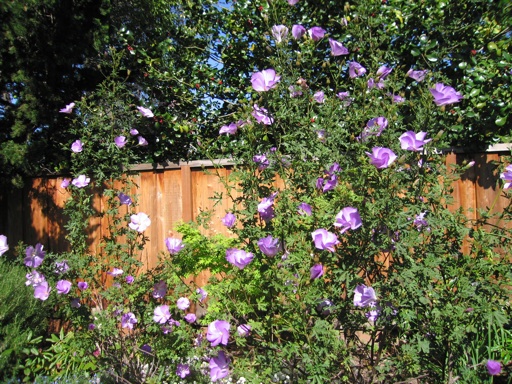
Our alyogyne bushes are in full bloom this month. Alyogyne huegelii is a perennial evergreen bush that produces striking lavender flowers. I planted our two Mood Indigo alyogyne bushes about 5 years ago. Each spring, they are covered with pinwheel shaped flowers for about 3 months. During that time, they make a great landscape display. Although in the summer and fall, they are not especially attractive.
Alyogyne rivals the princess flower. Both plants produce large purplish flowers. The flowers of alyogyne seem to stand out more against their foliage than princess flowers, but princess flowers usually bloom over a longer period. Also, alyogyne is more cold hardy than princess flower. Alyogyne is supposed to tolerate temperatures down to about 23 degrees F. Princess flower is usually damaged below 30 degrees F.
A few years ago when the temperatures here fell into the mid 20s in January, our alyogyne bushes were undamaged, but our princess flowers died to the ground. Obviously, neither of these plants are appropriate garden choices for most of the United States and Canada (i.e., USDA zones 1-8).
April 18 2009 | Alyogyne | Comments Off on Alyogyne
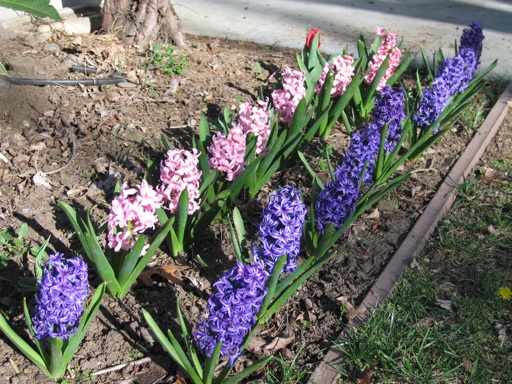
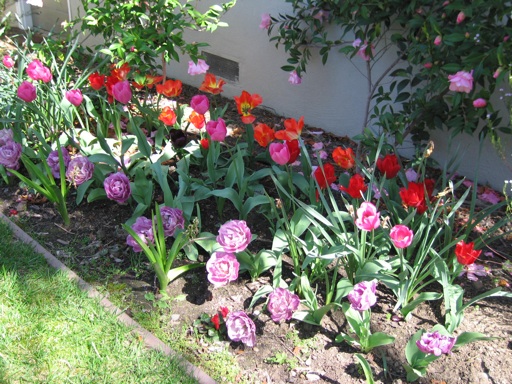
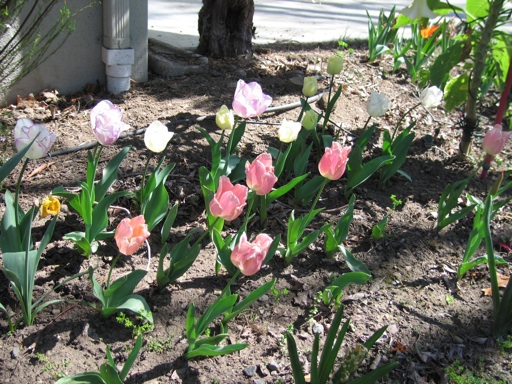
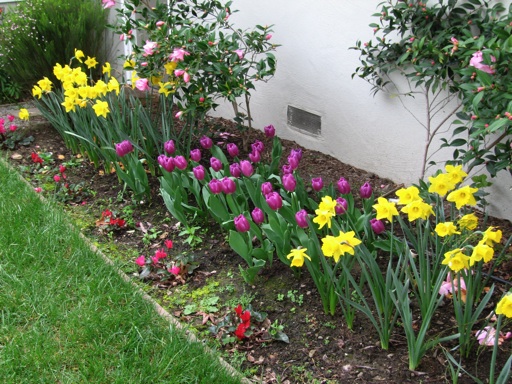
These pictures show some of the spring bulbs that have been blooming in our garden in the past few weeks. The hyacinths in the top picture were stunning at their peak about two weeks ago when I took this picture, especially the blue ones. Right now, the multicolored tulips in the second and third pictures are in full bloom.
Spring bulbs such as tulips, hyacinths, dutch irises, and daffodils are so beautiful and fun to grow. They make a wonderful landscape display for a few weeks in the springtime, because they tend to bloom at the same time and have such vibrant colors. I have gotten rave reviews from the neighbors about the color display.
Our climate doesn’t seem to get enough cold weather in the wintertime to stimulate tulips and hyacinths to continue blooming year after year. Freezes here are infrequent. Some sources say that one should dig up these bulbs and put them in the refrigerator for a month. Instead, I have been growing them as annuals, replanting them each fall and discarding some of the old ones. Our hyacinths usually bloom again more than one year, but they produce less flowers each year.
The fourth picture above showing the purple tulips and daffodils was taken in March 2008 of the same flower bed. I decided to diversify the color range of tulips I planted for this year’s display.
The same daffodils bloomed again back in February this year and have already faded away. Daffodils don’t seem to need much winter chill. They will bloom again year after year without any special care in our climate. I have seen them blooming along roads and highways in our area, obviously growing wild.
April 11 2009 | Daffodils and Hyacinths and Tulips | Comments Off on Spring Bulbs
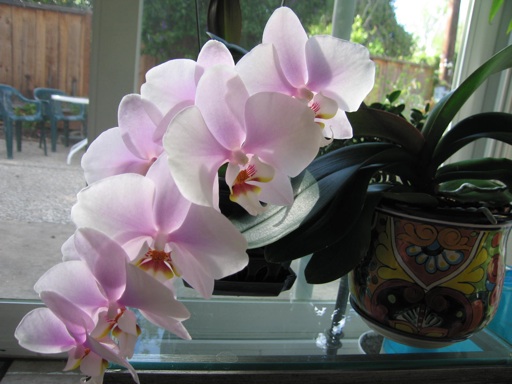
Last summer, my sister gave us an orchid plant that she had purchased some time ago. It had flowers on it when she bought it, but it had not bloomed again in the years since then. She gave it to us to see if we could get it to bloom again.
We soaked the orchid in a water bath with orchid fertilizer every 7-14 days, along with our other orchid plant, as described in my Nov. 4, 2008 post. After about two months, her orchid began to generate a new stem of flowers. That flower stem has been growing for about six months. It is now in full bloom. All 10 of the white and pink flowers on the stem are open at the same time right now. The first flower on the stem opened over a month ago.
I don’t often see orchids being sold in stores that have many flowers on a single stem all opened at the same time and all looking so perfect. I used to think it was difficult, if not impossible, to get orchids to bloom again and again indoors. But now that we have figured out the trick, it seems easy. Our other orchid featured in my posts on Sept. 28 and Nov. 4, 2008 is already generating another flower stem.
April 11 2009 | Orchids | Comments Off on Second Hand Orchid Blooming
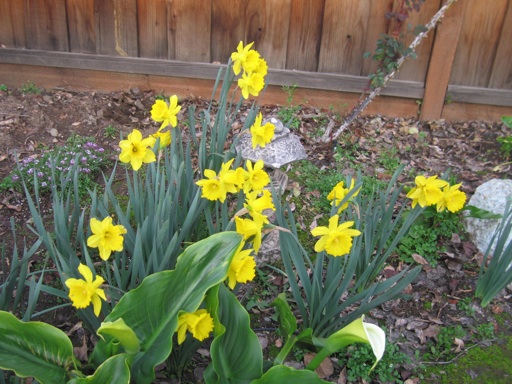
The daffodils I planted back in the fall of 2007 started to bloom again more than two weeks ago, and they are continuing to hold on to their color and shape. Daffodils are the first plants to start blooming in our yard this year. Nearly everything else is dormant. The yard looks relatively bare (see picture in my last post) so it’s nice to have some early spring color to look at.
Daffodils seem to require virtually no care in our climate. They usually get plenty of rain water in the winter as they are sprouting back to life. By the time the dry season begins in April, daffodils die back to the ground. They don’t seem to require watering while they are dormant. I didn’t water them very often last spring and summer. We received no rain from March through September, but despite the lack of rain, they came back to bloom again for a second time.
Also, daffodils don’t require a large amount of winter cold to bloom year after year like tulips and other types of spring flowering bulbs. We don’t get very much freezing weather here.
A few years ago, I made the mistake of planting daffodils under an eve of the house where they did not receive any rain water. Those daffodils grew back the next year, but they did not bloom. After a few more years, they died. I figured they died because they were not getting any water. I often see daffodils blooming alongside the freeway, so I guessed that they must be low maintenance plants. So I decided to plant more daffodils away from the house where they would receive rain. These are the daffodils in the picture.
February 28 2009 | Daffodils | Comments Off on Daffodil Blooms Signal Spring is Near
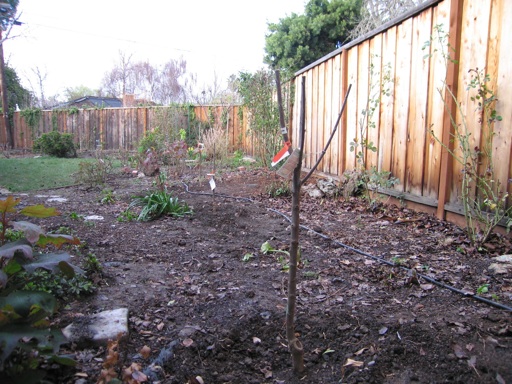
I am nuts about fruit trees! Last weekend, I spent time planting a few new fruit trees in our yard. I planted a Bing cherry, a Rainier cherry, and a Royal Rainier cherry. I also transplanted our small young apple trees and one small pear tree closer together to make room for the cherries. Yesterday, I planted an almond tree. We now have 3 apple trees, 4 cherry trees, 4 pear trees, one yellow peach tree, one white nectarine tree, 2 apricot trees, 1 fig tree, and 1 almond tree. We also have 3 orange bushes and a lemon bush.
Traditional orchards plant fruit trees 15-20 feet apart, because they grow so large when they are minimally pruned. Many publications also recommend that fruit trees in backyard orchards be spaced 15-20 feet apart. The problem is that our yard is only large enough to support about 4 or 5 trees at 20 feet apart and a large distance from the house and fence. Our lot is about 1/5 of an acre.
I have planted most of our fruit trees about nine feet apart. That’s much closer than most traditional orchardists would recommend. However, there has been a growing movement to plant fruit trees closer together in high density plantings. The idea is to plant many more different kinds of fruit trees close together in a smaller area to achieve a larger variety and a longer season of fresh backyard fruit. If the proper varieties are selected, a backyard fruit orchard can produce freshly ripened fruit from May through November. For example, one can plant early season ripening, mid-season ripening, and late season ripening peaches in one yard to get peach harvests from May through September.
In order make a high density fruit orchard manageable, the grower should be committed to size control. Some fruit trees are sold on dwarf rootstocks, but many varieties are not. Most of our fruit trees are grafted onto semi-dwarf rootstocks that will allow the trees to grow to 15-25 feet tall (or larger) and as wide. That’s far too large for a high density backyard planting. Fruit trees planted in high densities need to be keep small (e.g., 6-8 feet tall and wide) so that the branches do not grow together and shade each other.
I have recently read that the key to keeping fruit trees small is to prune them once in the spring (May) and again in the summer time (July-Sept.). Traditionally, fruit trees are pruned only during the dormant season in the winter time. However, if that technique is applied to a high density planting, the fruit trees will grow large root systems during each growing season. Then, if the trees are severely pruned during the winter months to control their size, they will grow back very vigorously during the next growing season, making it difficult to keep them small and manageable.
I have read that spring and summer pruning will keep the root system from storing too much food during the growing season, which will keep the tree from growing too vigorously during the next growing season. I have not tried the summer pruning technique yet, but I plan to start this year to maintain our trees at a height of no taller than about 7-8 feet. We have a few fruit trees that have already grown much larger than that, including a pear and a cherry. I may prune them gradually over a period of a few years to bring their size down.
I have found that large fruit trees (i.e., taller than about 8 feet) are difficult to manage. I have to put netting on many of our trees (even the apples) to keep squirrels from eating all of the fruit. It’s just not practical to net a large tree. Also, it’s difficult to harvest fruit from the top branches of a large tree. Cherries are especially difficult to harvest from tall branches, because the fruit is so small that it cannot be easily picked using a long pole with a wire basket at the end. And looking up for a long time while picking fruit can make one’s neck sore. At this point, I am convinced that growing fruit trees as large shrubs, rather than large trees, is the way to go.
Dave Wilson nursery is one of the suppliers of fruit trees that is promoting high density plantings. See e.g., http://www.davewilson.com/homegrown/BOC_explained.html. They recommend planting 3 or 4 trees in one hole at 18-24 inches apart or planting a hedge row of fruit trees 3 feet apart in the row. That seems a bit too close for my tastes right now, because I want to have room to walk between the trees. So I settled on a nine foot spacing, because that left just enough room to allow my current trees to fit into the available space along the back fence, about 6-7 feet from the fence.
However, I am still contemplating the possibility of buying more types of trees, possibly an early or late ripening peach! If that happens, I may have to cram a few of them in a little tighter. 😉
February 15 2009 | Fruit | Comments Off on High Density Fruit Tree Plantings
« Prev - Next »







